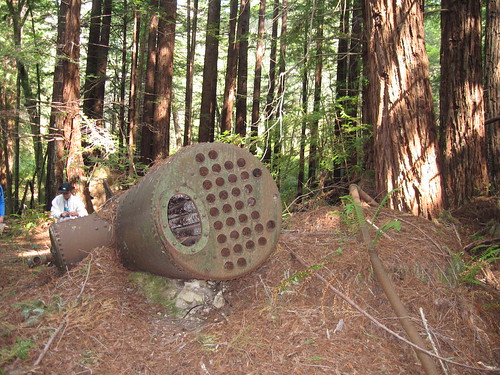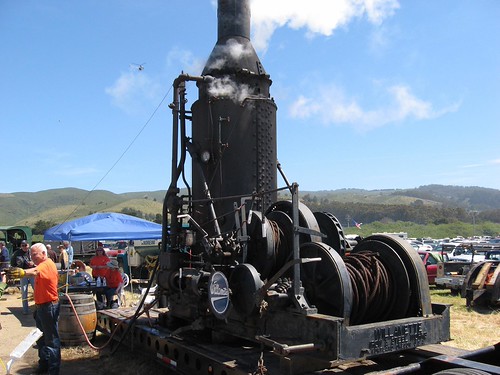Ammo box along the Tarwater Trail Loop in the Pescadero Creek
County Park. I first got the idea for this cache from talking to
steamloco. He knows a lot about this area and about train steam
engines in general. He kindly agreed to show me this wonderful old
sawmill site so that I could place a cache here.
The easiest way to reach this cache is from the entrance located
just off Alpine Road. Turn off Alpine Road at N37 17.227 W122
13.102. The parking lot and trailhead (Tarwater Loop) for this
cache will both be on your left at N37 16.568 W122 13.457. Enter
the trail on same side of the road as the parking lot, don't cross
the paved street. Parking is free. The park opens daily at 8:00
a.m., the closing time varies, depending on the time of year.
Please only cache during park hours. Closing time as well as other
park information (including trail maps) can be found at:
Park information, trail maps, weather and
directions
Although not initially visible from the main trail, the cache is
in a somewhat of a clearing. Very minimal bushwacking is required
to reach the sawmill site. You may have to cross a small seasonal
stream (most of the time no wading should be required; this could
change, depending on rain fall). Also, be aware there is a small
amount of poison oak in the area nearest the trail; it is easy to
avoid.
The approach to the cache is within sight of an old, rusting
“Steam Donkey” engine (at least what's left of it). Be sure and
take a few minutes to check it out. Very near the Steam Donkey you
can also see the remains of a portable sawmill. Tree cover is very
thick here and will almost certainly affect your coordinates. For
that reason I have provided a spoiler hint.
Steam Donkeys (or Donkey Steam Engines) were devices used for
logging. 1881 is usually recognized as the beginning of
technological change for the logging industry. Prior to 1881, logs
were carried by men, oxen and horses. This limited logging
operations to areas close to water (where the logs could be floated
to mills) or to flat ground (where animals could haul them).
However, in 1881 John Dolbeer applied for a patent for the donkey
steam engine. The invention of the Steam Donkey suddenly allowed
logging to be done much more efficiently and in many areas that
were previously inaccessible. As to why the term "Donkey" was used,
I found two possible answers. According to one source they were
called “Donkey” because because the original model looked too small
to be rated in horsepower. According to another source, the name
“Donkey” was because Dolbeer’s first model did involve a donkey
pulling the logs towards the engine.
If you are interested in learning more about the harvesting of
redwoods in the Santa Cruz mountains here is a great link by Palo
Alto online:
Redwood harvest: logging in the Santa Cruz
mountains
To get even more information, as well as see a picture of a
working Steam Donkey, here's another interesting link from
HistoryLink.org:
John Dolbeer invents the donkey engine and
revolutionizes logging
Congratulations to SugarBoogers for FTF and to alpharomero for
STF and getting the $10 REI giftcard prize left behind by
SugarBoogers.
Pescadero Creek County Park Steam Donkey (on its side):

Operating Steam Donkey:
